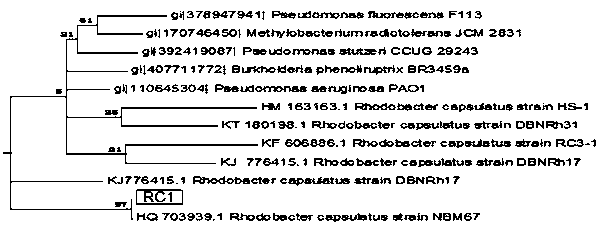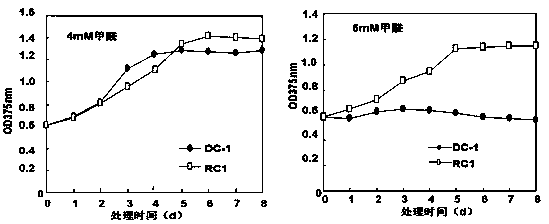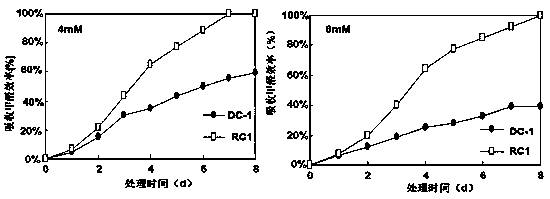Rhodobacter capsulatus strain RC1 and applications thereof
A technology of red bacteria and encapsulation, applied in the field of environmental microorganisms, can solve the problems of unclear composition and many types of activated sludge microorganisms, and achieve the effect of strong resistance
- Summary
- Abstract
- Description
- Claims
- Application Information
AI Technical Summary
Problems solved by technology
Method used
Image
Examples
Embodiment 1
[0018] Screening, identification and detection of embodiment 1 bacterial strain
[0019] The present invention first collects the bottom sludge water from the artificial wetland, adds different concentrations of formaldehyde to domesticate the microorganisms in the sludge water, and then uses the inorganic salt medium of photosynthetic bacteria to separate the photosynthetic bacteria that grow fast and have strong resistance to formaldehyde. The specific screening steps are:
[0020] 1. Domestication of activated sludge
[0021] Collect the sludge-containing water at the bottom of the artificial wetland anaerobic pool, filter it with gauze to remove large particles of impurities, add formaldehyde to the filtrate to domesticate the microorganisms in the sludge water, and the formaldehyde concentration increases from the initial 0.5mM to the final concentration every day. 10mM, continuous treatment for 20 days.
[0022] 2. Isolation of Photosynthetic Bacteria
[0023] After th...
Embodiment 2
[0028] Analysis of RC1's resistance to formaldehyde, formaldehyde removal effect and metabolic pathway
[0029] 1. Analysis of the resistance of RC1 to formaldehyde
[0030] An invention patent has been applied for a strain of capsulated rhodobacter ( Rhodobacter capsulatusstrain) DC-1 (201710038574.1), its preservation number in the China Center for Type Culture Collection is CCTCC NO: M2016676, this strain has the ability to remove formaldehyde and can be used to treat formaldehyde-contaminated sewage. In order to compare the physiological and biochemical characteristics of the strain, DC-1 and the isolated photosynthetic strain RC1 were inserted into anaerobic tubes containing 25ml of photosynthetic bacteria liquid medium, and when the OD375 of each bacteria was 0.5-0.6, respectively Add 4 mM, 6 mM formaldehyde, cultivate under light at 25°C, measure the OD375 of each bacterium at 1, 2, 3, 4, 5, 6, 7, and 8 days after inoculation, and observe the growth status of each bact...
PUM
 Login to View More
Login to View More Abstract
Description
Claims
Application Information
 Login to View More
Login to View More - R&D
- Intellectual Property
- Life Sciences
- Materials
- Tech Scout
- Unparalleled Data Quality
- Higher Quality Content
- 60% Fewer Hallucinations
Browse by: Latest US Patents, China's latest patents, Technical Efficacy Thesaurus, Application Domain, Technology Topic, Popular Technical Reports.
© 2025 PatSnap. All rights reserved.Legal|Privacy policy|Modern Slavery Act Transparency Statement|Sitemap|About US| Contact US: help@patsnap.com



